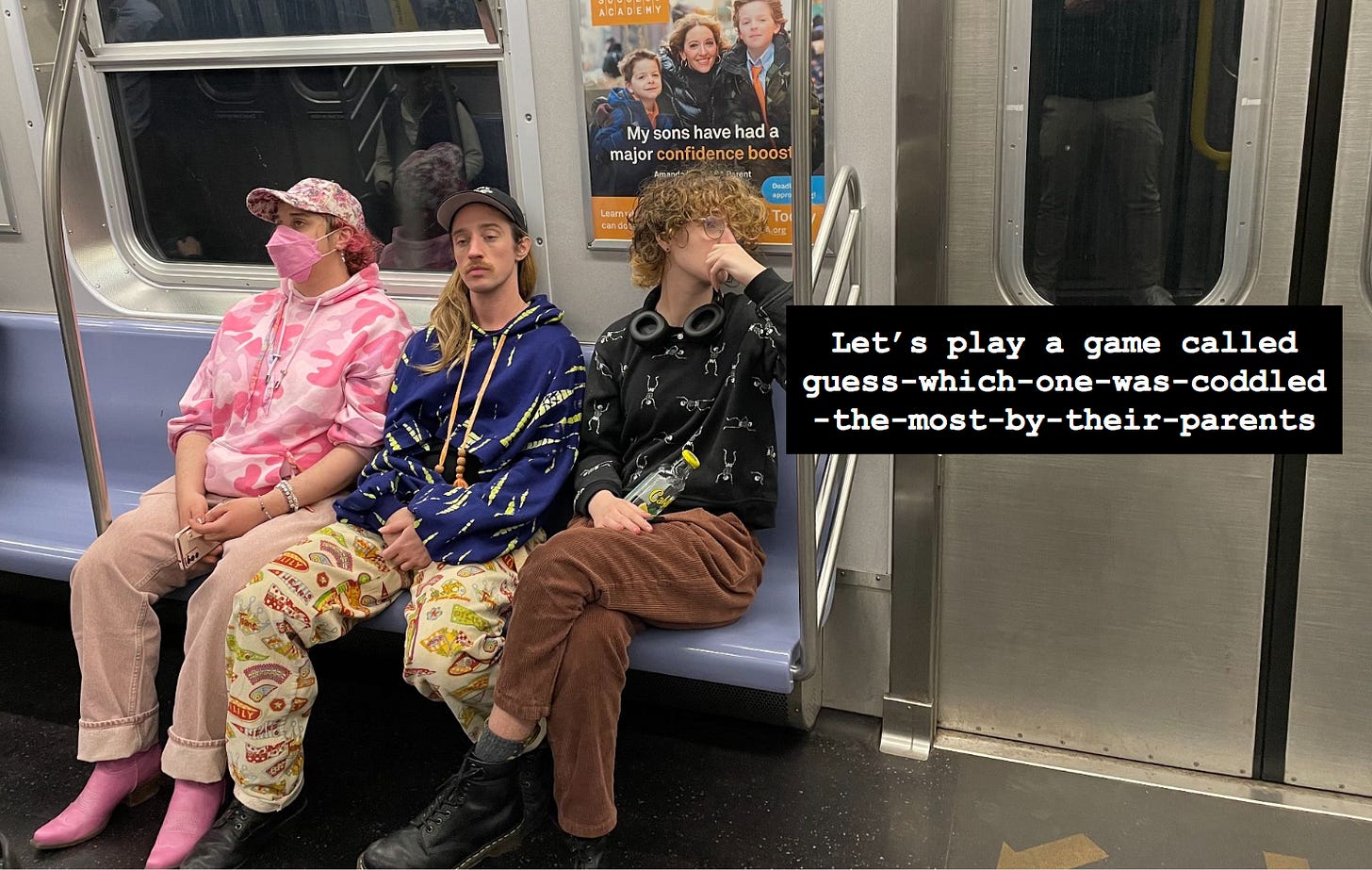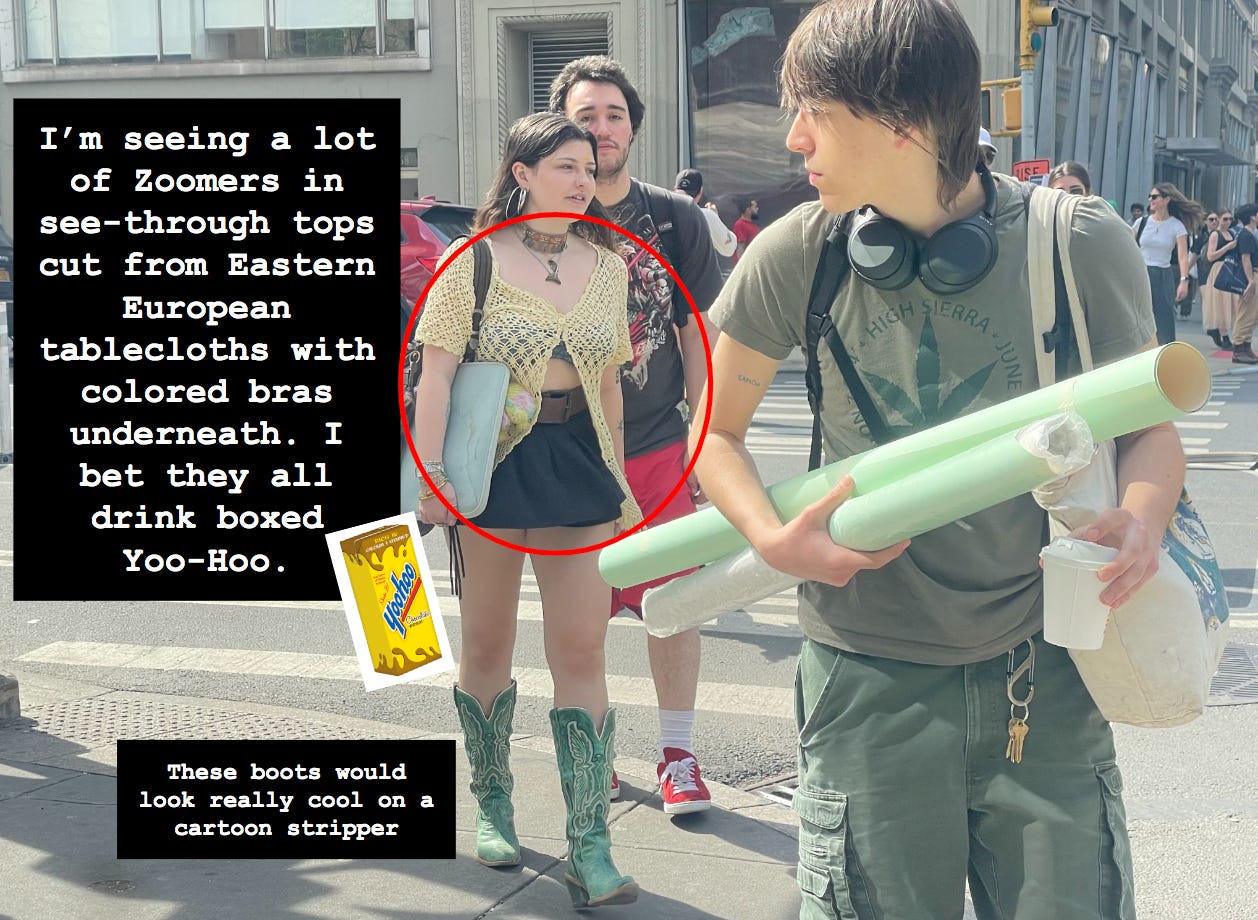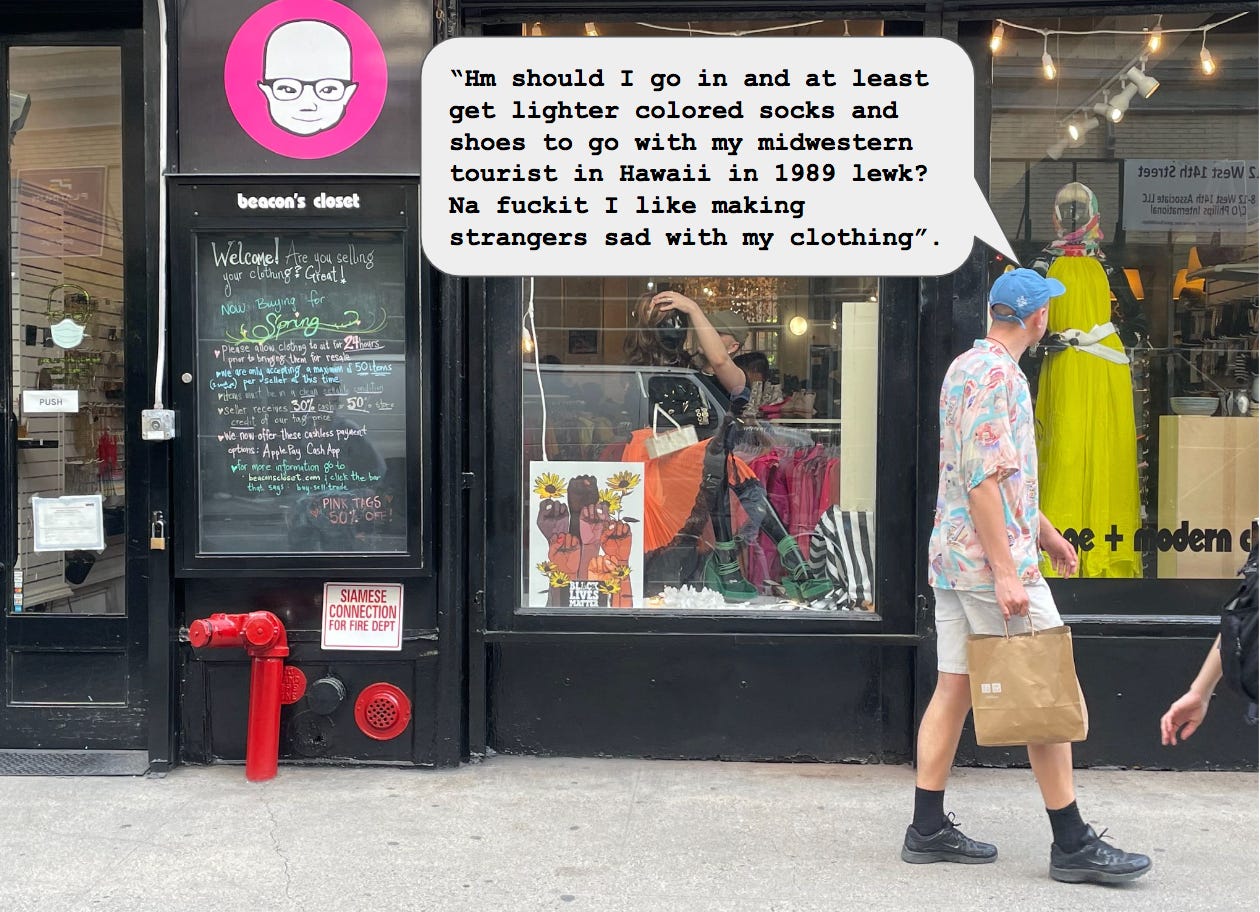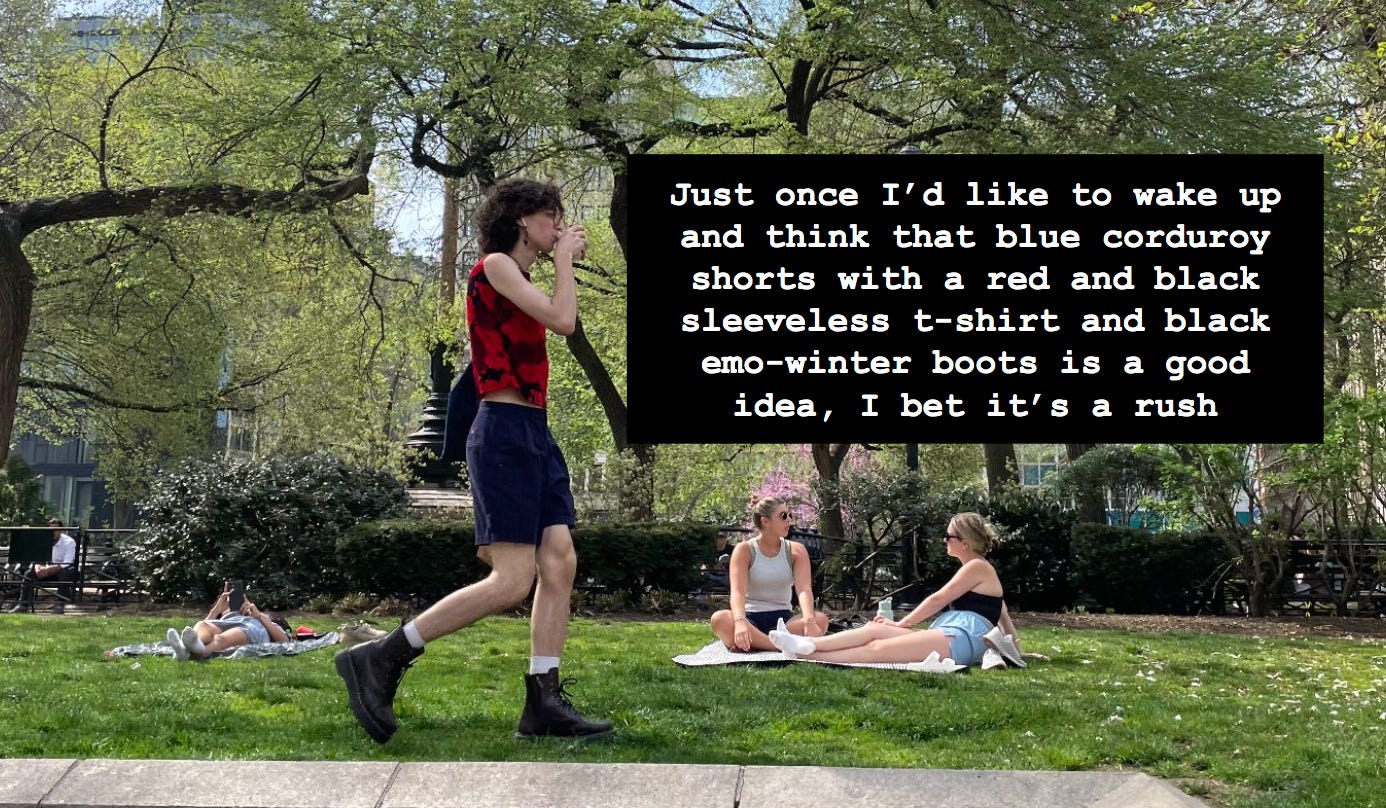Gen Z fashion: why it's so perplexingly horrific
Why does everyone born after 1996 dress like angry colorblind dumpster sloths?
Listen instead of reading so that you can multitask bad habits:
The timeline of every generation is punctuated by a collective fashion statement that becomes their unshakable visual identity. The boomers had Unshowered Hippy, Gen X had Sad in Plaid and Millennials are still running around Williamsburg covered in super expensive earth tone rags cut into capes, robes and kimonos decorated with stars, Hindu or Aztec symbols, and the fractals they see while tripping in Upstate yurts. It seems that after wandering around the fashion desert, momentarily embracing the shrill Neon Nineties and flirting with Thrift Store Goddess, Gen Z has finally found the look that eternally defines their entire population: Totally Unfuckable.
With the exception of people in LA, Spring is the time that everyone puts effort into how they look after five reclusive, solitary months of eating pasta and watching foreign language Netflix in 11-year-old pajamas (pasta is a schedule 1 controlled substance in LA, people watch foreign language Netflix communally at backyard / side-alley tofu BBQs, and they have their daytime pajamas custom made by a tailor in K-town). The third week of April is when New Yorkers, clad in pastel tank tops and sneakers almost as white as their legs, are confident enough that the dry, calloused hand of winter will not bitch-slap them back into brown flannel submission, and everyone steps out into our 72-hour spring to serve declarative looks (or lewks if you’re the worst). Gen Z has been the most cohesive, on-brand generation in terms of mood (anxious) and behavior (entitled), and enough of them have been spotted slouching on the catwalk that is the L train, waiting to put their name on the list at Kiki’s, or tantrum-journalling at Cha Cha Matcha to discern their universal sartorial formula:
The astonishingly repellent outcome of this formula may explain why Gen Z has the least amount of sex of any generation, except of course for the generations that no longer have sex because they are deceased.
One might assume that their fashion trespasses are because they’re poor, but one must also assume that there is an abundance of muted basics and inoffensive patterns at Goodwill, and everyone knows that shoplifting has been decriminalized in coastal US cities, because lawlessness has become a vibe. Most of these elderly children also still probably have a chunk of the wardrobe given to them by their parents, who also gave them far too many participation medals. Given this range of sourcing options, it would seem that Gen Z have chosen to weaponize bad style into a willful visual assault on anyone who looks at them. Since the world has tired of listening to Gen Z whine, they have turned their aggressively mismatched, hideously colored, astoundingly ill-fitting clothing into a passive aggressive proxy for the middle finger they inexplicably raise in Polaroid photos.
We must summon what is left of our compassion for Gen Z and interpret their grotesque fashion as a cry for help. I took it upon myself to talk with a few Zoomers and mine for the pain they must be masking with their painful clothing during my trip home from House of Yes on the L train.
Keating Hilmberg, 24, came to New York City after graduating from Swarthmore College Zoom classes in 2021 and was still wearing Patagonia shells and Old Navy cords. Recognizing how competitive it is to attract attention on the burlesque catwalk that is Wyckoff Avenue in Bushwick, he knew he needed a makeover.
“I feel like the media agency I work at should have given me a clothing allowance, but since they’re fascists and didn’t, I cut my food budget by living on the Sun Chips and almonds from the office cafeteria and just like, plowed all my money into building a sick wardrobe,” he explained. My Spring allergies were kicking in, and I wondered if his large septum nose ring made sneezing perilous.
“How would you describe your personal style?” I asked.
“Fucking send it, bro,” he replied. “Like, I look for shit that people never thought was wearable and I make it cool. I wear the impossible.” Indeed you do, I thought. “I think that’s the Gen Z vibe - we’re the generation that believes in the impossible, and like, when it comes to fashion, we want to break out of the box.” And into a trash bag, I thought to myself and maybe also said aloud.
“What do you think your generation is trying to say with your style?” I ask, hoping to surface some vulnerability and depth.
“We care a lot about a lot of different things, especially ourselves and things about us, and our fashion is about us and those things,” he says as he watches a TikTok video of a young woman laughing and running through a computer-generated forest of flames. I walk away as his dopamine trip kicks in.
Kimothée Thibault, a 22-year-old recent NYU grad, describes herself as a multimedia artist who splits her time between the West Village apartment that her parents purchased for her and the Bridgehampton beach house that her parents purchased for themselves.
“May I ask the origin of your name?” I inquire, ready to blame her parents.
“My parents named me Kimberly, but I really identify with Timothée Chalamet,” she croaks in a vocal-fry that is more fried than an electrocuted panko-crusted chicken wing left in the sun on a beach in Ecuador for three days during Summer solstice.
“Cool,” I say, wondering if she can see through my eyes and into my imagination, where Timothée Chalamet is crying after I launched a spitball onto his sunken cheek in the lunchroom of a junior high school cafeteria in a suburb of Cleveland. “Tell me about your personal style.”
“I really like sleep, and wearing pajamas during the day makes me feel like I’m still sleeping when I’m not asleep.” I realize now that her bedhead is not styled and is actually from her lived experience, as opposed to a type of experience that is somehow not lived.
“I get emails from people who tell me to do things sometimes,” she says with her eyes closed. I pivot away from the topic of work, which apparently does not resonate with her.
“How would you define Gen Z style?”
“We don’t like being defined. We prefer to be interpreted,” she says, her eyes still closed.
“What’s the story behind your hoodie?” I ask. She opens her eyes and looks at the pink unicorn and black crucifix covered XXXXL hoodie that hangs well below the waist of her baggy plaid pajama bottoms, frowns a bit, and then nods with recollection.
“I won it at a talent show in Los Feliz during high school,” she says, still nodding.
“What was your talent?” I ask, wondering if surviving at the risky center of the improbable Venn diagram of annoying, boring and tedious is a category.
“I can cry on demand. Want to see?”
“No no, I trust you,” I assure her, ready to avert my eyes and run away at the faintest hint of eyeball humidity. I decide to try an innocuous question that I think is less likely to yield an answer that makes me want to die.
“What’s your favorite color?”
“It doesn’t have a name,” she says, proving me completely wrong.
“Well, what color is it most similar to?” I ask, masochistically.
“Like, clouds before a thunderstorm mixed with rainbow cotton candy with a little bit of polyracial skin tone,” she says, looking up wistfully at the sky even though we’re on the L train.
“I can’t picture that even a little bit, but it sounds cool,” I say, standing up. “Well, this is my stop.”
“But we’re under the East River right now.”
“Yeah, I live on a boat,” I say, walking away. “Take care, Kimothée.” She closes her eyes again and waves with her pinky.
I spot a person who appears to be in their early twenties, whose gender isn’t immediately discernible, wearing a rust colored jumpsuit with a silver sequined tank top underneath it. They actually look kind of dope, albeit in a terrible way. Running out of time and patience, as we’re almost at 14th street and I’m tired of talking with alien life forms, I optimize for directness and efficiency.
“Hi. You appear to be a member of Gen Z,” I declare. They look up at me and nod apprehensively. “Why do you all dress like you hate the entire world?”
“Because everyone mistakes us for millennials,” they say with a mix of sadness and disgust, the two emotions that Gen Z fashion evokes.
Case closed.












I absolutely love Gen Z’s joyful street style even if it’s not how I personally dress. As an elder millennial with both a Gen Z son and a Gen A daughter, it makes me so happy that their general attitude of tossing out rules just for the sake of rules bleeds into their fashion sense.
The hate they get feels so similar to the pushback that 1920s flapper fashion received at the time, maybe because they both inherited a world that felt doomed. When the world is burning around you, why would you embrace the societal and fashion norms of the generations that served you this mess?
So funny! That's what happens when you get to grow zero self respect and instead get substitutes handed to you in the form of lots of fake achievement tokens, freebies, goody bags and 'what would u like now honey'.